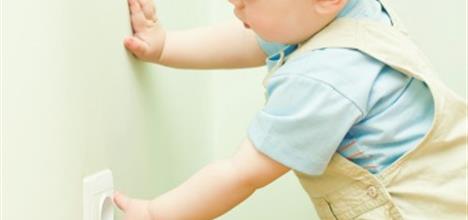Electric Shock Injuries in Children (original) (raw)


Page Content
When the human body comes into direct contact with a source of electricity, the current passes through it, producing what's called an electric shock. Depending on the voltage of the current and the length of contact, this shock can cause anything from minor discomfort to serious injury (even death).
Young children, particularly toddlers, experience electric shock most often when they bite into electrical cords or poke metal objects such as forks or knives into unprotected outlets or appliances. These injuries can also take place when electric toys, appliances, or tools are used incorrectly or when electric current makes contact with water in which a child is sitting or standing. Christmas trees and their lights are a seasonal hazard.
Prevention
The best way to prevent electrical injuries is to cover all outlets, make sure all wires are properly insulated, tuck wires away from your child's reach, and provide adult supervision whenever children are in an area with potential electrical hazards. Small appliances are a special hazard around bathtubs or pools.
What You Can Do
- Disconnect the power supply before you touch an injured child who is still receiving current; pull the plug or turn off the main switch.
- Never touch a live wire with your bare hands. If you have to lift a live wire from a child, use a dry stick, a rolled-up newspaper, thick clothing, or another sturdy, dry, nonmetallic object that won't conduct electricity.
- Move the child as little as possible because severe electric shock may have caused a spinal fracture.
- If you can't remove the source of the current, try to move the child, but don't use your bare hands. Insulate yourself with rubber or with any of the nonconductive items suggested for lifting a live wire so that the current doesn't pass from the child's body to yours.
- Once the current is off, quickly check the child's breathing, pulse, skin color, and alertness. If the child isn't breathing or there is no heartbeat, begin CPR immediately while someone else goes for medical help.
- Once the child is safely removed from the current, check him for burns and call 911, your local emergency number, or your pediatrician right away.
Treatment
- A child who has received an electric shock should be seen by a pediatrician because shock may cause internal damage that can't be detected without a medical examination.
- Your pediatrician will clean and dress surface burns and order tests for signs of damage to internal organs.
- Mouth burns (such as from biting an electric cord) are often much deeper than they appear. Your child may require surgery after the initial healing. Parents must be alert to the possibility of bleeding from mouth burns hours or even days after the injury. If bleeding occurs, apply a clean pad and call your pediatrician immediately. See First Aid for Burns: Parent FAQs.
- If a child has severe burns or any sign of brain or heart damage, she will need to be placed in a hospital.
Additional Information on HealthyChildren.org:
Article Body
Last Updated
9/26/2019
Source
The Big Book of Symptoms: A-Z Guide to Your Child’s Health (Copyright © 2014 American Academy of Pediatrics)
The information contained on this Web site should not be used as a substitute for the medical care and advice of your pediatrician. There may be variations in treatment that your pediatrician may recommend based on individual facts and circumstances.